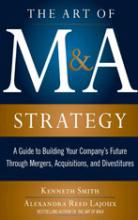Fundamentals of M&A: An Excerpt from The Art of M&A Book Series
By Kenneth Smith and Alexandra Reed Lajoux

The Art of M&A Strategy - Preface
A major merger or acquisition can be a company-defining moment. On the one hand, the right business combination at the right price, with good execution, can reposition the company, accelerate profitable growth and shareholder return, and even change the game for the industry as a whole. On the other hand, a bad deal – whether the failure is in the concept, the price, or the execution – can quickly destroy shareholder value in an otherwise healthy company.
Yet, despite the risks, strategic M&A is here to stay because the business environment is changing, and companies must change to compete. New technology, re-regulation, and continued globalization are driving restructuring in almost every sector. Technology advancements are resulting in new business models, such as e-commerce and social marketing, calling for new skills and partnerships. The changing regulatory landscape for broad industry sectors such as health care and financial services will alter the economics of many businesses and drive mergers and divestitures as companies reposition to compete. Globalization is presenting new opportunities for international value chains and international markets, and in so doing it is changing the requirements for competitive scale and scope from the domestic to the global context.
Potential Value of Mergers
In such an environment, mergers, acquisitions, and divestitures are powerful and increasingly important weapons of strategy. The term weapons is apt: the word strategy derives from the Greek word strategein, to lead an army in battle. If an industry is restructuring, mergers may be a requirement to maintain competitive scale or may be the only means to achieve leadership. If a company’s strategy calls for growth, new market entry, or repositioning in the value chain, acquisitions can be the fastest means of achievement. If a portfolio of businesses or products (whether acquired or homegrown) requires pruning, divestitures can enhance shareholder value for the seller and buyer alike.
When acquisitions are pursued for strategic reasons, they are much more likely to succeed for shareholders. Indeed, many strategic acquisitions have created substantial shareholder value, not only in deal implementation but also by catalyzing transformation. IBM’s acquisition of Lotus earned many times the premium paid for Lotus and in addition was a key step in IBM’s transformation from a hardware company to a software and services company. The merger of Canadian National Railways with Illinois Central created the first North American railway from sea to sea and created a growth stock in an old industry. Thomson-Reuters is the product of successive divestitures and acquisitions that converted a newspaper chain in a declining industry into a global leader in information services.
Make or Break
However, while the execution of a well-planned strategic deal can make a company, it can also break a company. Some of the worst deals of the last decade across a range of industry sectors serve to illustrate the risks: in telecommunications, BCE’s investment in Teleglobe, which then spiraled into bankruptcy; in life sciences, Upjohn’s initial attempt to integrate Pharmacia, failing to recognize that the two companies were an ocean apart in corporate culture as well as geography; in professional services, Paris-based Cap Gemini’s retention of only a fraction of the assets it acquired from Ernst & Young Consulting because the best assets had legs and walked away from the stock-based retention incentives; in consumer products, the Quaker Oats acquisition of Snapple and its subsequent sale at a fraction of the value – earning this deal a place among the 10 transactions dubbed by Robert Bruner as “Deals from Hell.”1
Note that these were all otherwise reasonably successful, well-run companies.
The Downside: Value Destruction
Acquisition failures do not have to make the headlines to be disasters for shareholders. An international study of more than two thousand large transactions (billion dollar plus) in North America and Europe in the last decade found that over half have destroyed shareholder value.2 Among these, many have been doomed from the outset by an ill-conceived strategy or, more often, unrealistically optimistic expectations of the “synergies” – the ways in which two companies would complement, supplement, or leverage each other to make “1 plus 1 equal 3.” In the worst cases, strategies have been hastily developed when the market presents an irresistible opportunity. In many other cases, the deal had the potential to create value, but the means of value creation were considered only superficially. As a result, the synergies were overestimated or the means to achievement were underestimated; so the price paid for the company was in excess of the value created after the deal. Well in excess of $1 trillion in shareholder value has dissipated in the last decade – not in deals that fell apart but in deals that simply failed to deliver.
______________________________________________
Lajoux, Alexandra Reed and Smith, Kenneth. “The Art of M&A Strategy - Preface” The Art of M&A Strategy: A Guide to Building Your Company's Future Through Mergers, Acquisitions, and Divestitures. United States of America: McGraw Hill, 2012. Pp. ix-xi. Print.
For a complete list of references/notes within this article please call the M&A Leadership Council at 214-689-3800.